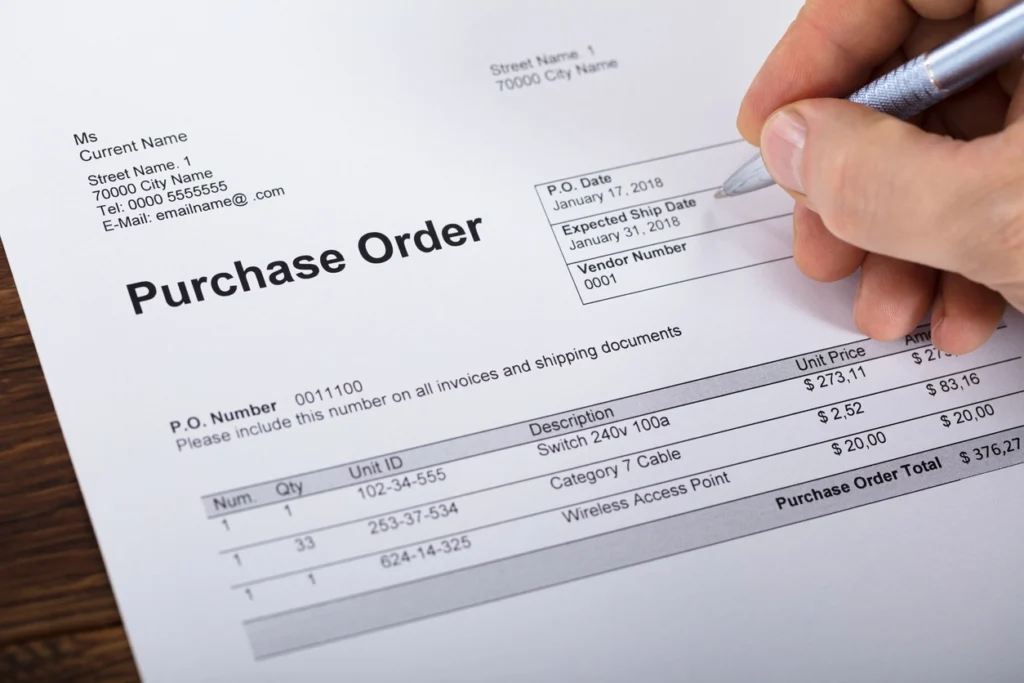In the world of business, purchase orders (POs) are the backbone of getting what you need to operate. Think of them as the official “I want this” document you send to your suppliers. But managing POs, especially within Salesforce Purchase Order, can feel like wrestling an octopus – complex and messy!
Salesforce is amazing for managing customer relationships, but purchase orders often require a tailored approach. That’s why we created this ultimate guide. Whether you’re new to POs or a Salesforce pro, we’ll demystify the process and uncover hidden strategies to streamline your purchasing.
This guide promises to:
- Clearly explain the fundamentals of purchase orders: What they are, different types, and their entire lifecycle.
- Solve your specific Salesforce PO problems: From choosing the right tools to building custom solutions, we’ll tackle any obstacle.
- Empower you to make smarter choices: You’ll gain the knowledge to optimize your purchase order process, saving time and money.
Let’s dive in and transform your Salesforce POs from a source of stress into a well-oiled machine!

Understanding Purchase Order Fundamentals
Before diving into Salesforce specifics, let’s solidify your foundation. A purchase order isn’t just paperwork; it’s a legally binding agreement. Getting the basics right avoids costly mistakes further down the line.
Types of POs
Not all POs are created equal! Here’s a breakdown of the most common types, and when you’ll likely use them:
- Standard PO: The workhorse of POs. Used for one-time purchases of specific items or services with a set price and quantity.
- Planned PO: Ideal for recurring orders placed on a schedule. Think office supplies or raw materials with predictable usage rates.
- Blanket PO: Gives flexibility for frequent purchases from the same supplier over a period. Great when exact quantities are hard to predict upfront.
- Contract Manufacturing PO: Specifically for complex, custom-made products. Includes detailed specifications and production timelines.
Important Note: Industries might have additional specialized PO types. If you work in a niche field, it’s worth doing some quick research to see if any apply.
The PO Lifecycle
Picture your PO as a traveler on a journey. Here’s the typical route:
- Creation: Someone in your company identifies a need and drafts the PO with all essential details (items, prices, vendor info, etc.).
- Approval: Depending on your company’s rules, the PO may need to get a green light from a manager before being sent.
- Sending: PO is officially transmitted to the supplier, usually by email or through a specialized platform.
- Receiving: The goods arrive! Checking them against the PO is crucial to catch any errors.
- Invoicing: The supplier sends the bill, and it’s matched against the PO for accuracy before payment.
Best Practices
Want your PO process to run smoothly? Here are some timeless tips:
- Centralize your PO data: Avoid losing track of POs in email threads or spreadsheets.
- Standardize templates: Ensure everyone uses the same format, reducing confusion.
- Clear approval chains: Define who signs off on different spending levels.
- Track changes: Log any updates for future reference in case of disputes.

Mastering Salesforce Purchase Order
Salesforce is a powerhouse, but its standard “Orders” object wasn’t built with the full complexity of purchase order management in mind. That’s why it’s crucial to understand your options for getting the most out of the platform.
Limitations of Native Orders
While you can technically track purchase orders using Salesforce’s basic features, there are often limitations:
- Flexibility: If you need custom fields, complex approval flows, or specialized PO types, adapting the basic order object can be tricky.
- Integration: Connecting your PO data seamlessly with inventory management, accounting, or other systems may require complex workarounds.
- Reporting: Building robust reports to track PO status, spending trends, and other key metrics can be time-consuming.
AppExchange Solutions
The Salesforce AppExchange is your treasure trove for dedicated purchase order management apps. Here’s the approach:
- App Overview: We’ll introduce the top-rated apps, outlining their features, strengths, and best-fit scenarios.
- Comparison Table: Break down pricing, features, and target industries so you can compare your top choices side-by-side.
- First-Hand Experience: Depending on access, we’ll aim to include insights from testing out a few leading options.
Custom Development
Sometimes, the best fit is a tailored solution. We’ll discuss when to consider this path:
- Highly Unique Needs: If your industry or PO process is truly niche, off-the-shelf might not cut it.
- Deep Integration: Building custom workflows when syncing PO data with multiple complex systems is involved.
- Legacy System Tie-Ins: If you need to connect to older, custom-built software, this often requires customization.
Enhancing Your Salesforce Purchase Order Process
Now that you grasp the tools at your disposal, it’s time to make them work for you! Let’s harness Salesforce’s power to streamline your PO system and get valuable business insights.
Workflow Automation
Imagine your POs breezing through approvals and sending updates without constant manual nudging. Salesforce Flow is your key to making this happen! Here are some practical examples:
- Approval Routing: Automate multi-level approvals based on total PO amounts, departments, or even specific items being ordered.
- Notifications: Keep stakeholders informed when POs are created, approved, shipped, or received. No more missed deadlines!
- Data Updates: Automatically trigger updates to related records (inventory, project budgets) when a PO’s status changes.
Integration Power
Salesforce shines brightest when it plays well with other systems. Here’s how to make your PO data flow seamlessly:
- Invoicing Integration: Connect with your accounting software to easily match invoices to approved POs, accelerating payments.
- Inventory Management: Ensure stock levels are automatically updated when POs are received, preventing costly over or understocking.
- CRM Sync: Maintain a clear view of supplier relationships, purchase history, and contract details directly linked to Salesforce accounts.
Analytics & Reporting
Knowledge is power, and your PO data tells a story! Let’s illuminate it with Salesforce reports and dashboards:
- Spending Trends: Spot patterns for smarter negotiations and budgeting. Track spending by department, vendor, or item category.
- Approval Bottlenecks: Identify where POs get stuck, allowing you to streamline the process and avoid delays.
- Vendor Performance Track on-time delivery rates and compare pricing to help make informed sourcing decisions.

Common Challenges and Troubleshooting in Salesforce
Even the best-laid plans can hit snags. Let’s confront the frequent frustrations when dealing with Salesforce POs and give you the tools to overcome them.
Frequent Pain Points
- Data Syncing Issues: PO information not updating correctly between Salesforce and external systems can cause chaos.
- Approval Bottlenecks: Slow approvals halt progress, especially when managers are away or overloaded.
- Customization Limitations: Feeling boxed-in by what you can modify with standard features or AppExchange apps.
- User Adoption: Change is hard! Getting your team onboard with a new system or process can be an unexpected hurdle.
Solutions and Workarounds
For each challenge, we’ll provide:
- Troubleshooting Steps: Clear instructions for identifying and fixing the root cause of problems.
- Workarounds: When full fixes aren’t possible, practical ways to mitigate the issue and keep work moving.
- Example Scenarios: Make the solutions relatable by connecting them to common real-world scenarios.
Preventive Measures
Nobody enjoys putting out fires! We’ll cover proactive tips like:
- Thorough Testing: Emphasize the importance of testing any changes in a sandbox environment before going live.
- User Training: Investing in clear documentation and training sessions minimizes confusion and errors.
- Regular Reviews: Schedule check-ins to catch small problems before they become major headaches.
Staying Up-to-Date with Salesforce PO Innovations
Salesforce and the wider world of business technology never stand still. Let’s ensure you’re always prepared to take advantage of the latest advancements in purchase order management.
Salesforce Release Notes
Three times a year, Salesforce unleashes updates! Here’s how to stay on top of PO-relevant changes:
- Where to Find Them: We’ll provide the official link to Salesforce release notes, categorized by feature area.
- How to Search: Tips for searching keywords to quickly find relevant updates (e.g., “purchase order,” “procurement,” “approval flows”).
- Interpreting the Notes: Help in understanding the jargon and identifying which updates are worth investigating further.

Transform Your Purchase Orders with Salesforce: Your Ultimate Guide
Whether you’re a Salesforce beginner navigating purchase orders for the first time or a seasoned pro looking to optimize your process, this guide has empowered you. You now possess the knowledge to choose the right PO approach for your business, streamline workflows, and gain actionable insights from your data.
The time and money saved with an efficiently-managed Salesforce PO system is a direct investment in your business’s success. It translates to smarter spending, stronger supplier relationships, and less frustration. And with the strategies for staying up-to-date, you won’t be caught off guard by exciting innovations in the Salesforce ecosystem.
Frequently Asked Questions About Salesforce Purchase Order
Can I use Salesforce to track purchase orders for services as well as physical goods?
Absolutely! While we often think of purchase orders for tangible items, they’re equally important for services. A PO for a service should include:
- Clear description of the service being provided
- Timeline or milestones for completion
- Rates (hourly, project-based, etc.)
- Any deliverables or acceptance criteria
Our products have very specific requirements. Can I handle custom fields and complex specifications within Salesforce?
Yes, but the best approach depends on the level of complexity. Here’s a breakdown:
- Minor Customization: Salesforce’s standard objects can often handle extra fields.
- Moderate Complexity: AppExchange apps may have features for specialized details and document attachments.
- Extreme Customization For truly unique needs, custom development might be necessary to build the perfect forms and data structure.
Can I use Salesforce purchase orders for international suppliers?
Yes, but there are extra considerations:
- Currency: Ensure your system handles multiple currencies and exchange rates, either natively or through an integrated app.
- Compliance: Be aware of potential import/export regulations specific to your industry and the countries involved.
- Logistics: Factor in longer shipping times and consider tools to track shipments internationally.
How does electronic signature software integrate with Salesforce purchase orders?
E-signatures can significantly speed up your PO process! Several integration options exist depending on your preferred e-signature provider:
- Native AppExchange Solutions: Some providers have dedicated apps streamlining signature workflows within Salesforce.
- API Connections: If your e-signature tool has an API, a developer can build a custom integration.
- External Routing: Even without a direct link, you can set up flows to send the PO for signature and then update Salesforce when complete.
We’re a s mall business. Is it worth investing in a dedicated Salesforce purchase order solution?
The benefits often outweigh the costs, even for small businesses. Here’s why:
- Saves Time: Eliminating manual tasks and spreadsheets frees up hours each week.
- Reduces Errors: Automated checks and centralized data minimize costly mistakes.
- Better Visibility: Real-time insights into spending and vendor performance help you make smarter decisions. Consider starting with a lower-cost AppExchange solution and scaling up as your needs grow.